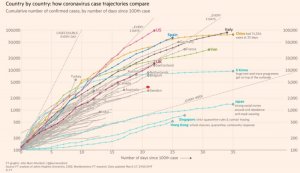sars-CoV-2 behaves like a monstrous mutant hybrid of all the human coronaviruses that came before it. It can infect and replicate throughout our airways.
“That’s why it is so bad,” Stanley Perlman, a professor of microbiology and immunology who has been studying coronaviruses for more than three decades, told me.
“It has the lower-respiratory severity of sars and mers coronaviruses, and the transmissibility of cold coronaviruses.”
While the first sars virus attached to the ACE-2 receptor, as well, sars-CoV-2 binds to it ten times more efficiently, Kizzmekia Corbett, the scientific lead of the coronavirus program at the National Institutes of Health Vaccine Research Center, told me. “The binding is tighter, which could potentially mean that the beginning of the infection process is just more efficient.” sars-CoV-2 also seems to have a unique ability, which sars and mers did not have, to use enzymes from our human tissue—including one, widely available in our bodies, named furin—to sever the spike protein’s cap from its stem. Only then can the stem fuse the virus membrane and the human-cell membrane together, allowing the virus to spit its RNA into the cell. According to Lisa Gralinski, an assistant professor in the Department of Epidemiology at the University of North Carolina at Chapel Hill, this supercharged ability to bind to the ACE-2 receptor, and to use human enzymes to activate fusion, “could aid a lot in the transmissibility of this new virus and in seeding infections at a higher level.”
Unlike other RNA viruses, however, coronaviruses do have some capacity to check for errors when they replicate. “They have an enzyme that actually corrects mistakes,” Denison told me.
It was Denison’s lab at Vanderbilt that first confirmed, in experiments on live viruses, the existence of this enzyme, which makes coronaviruses, in a sense, cunning mutators. The viruses can remain stable in a host when there is no selective pressure to change, but rapidly evolve when necessary. Each time they leap into a new species, for example, they are able to hastily transform in order to survive in the new environment, with its new physiology and a new immune system to battle. Once the virus is spreading easily within a species, though, its attitude is, “I’m happy, I’m good, no need to change,” Denison said. That seems to be playing out now in humans; as sars-CoV-2 circles the globe, there are slight variations among its strains, but none of them seem to affect the virus’s behavior. “This is not a virus that is rapidly adapting. It’s like the best car in the Indy 500. It’s out in front and there is no obstacle in its path. So there is no benefit to changing that car.”
A virus replicates in order to shed from its host—through mucus, snot, phlegm, and even our breath—as soon as possible, in great quantities, so that it can keep spreading. The coronavirus happens to be a brilliant shedder. A preprint study by German researchers, published earlier this month, and one of the first outside China to examine data from patients diagnosed with covid-19, found clear evidence that infected people shed the coronavirus at significant rates before they develop symptoms. In effect—possibly due to that supercharged ability to bind and fuse to our cells—the virus wears an invisibility cloak. Scientists recently estimated that undocumented cases of covid-19, or infected people with mild symptoms, are fifty-five per cent as contagious as severe cases. Another study found that in more severe cases (requiring hospitalization), patients shed the virus from their respiratory tracts for as long as thirty-seven days.
A hundred million coronavirus particles could fit on the head of a pin—typically, thousands or tens of thousands are necessary to infect an animal or a person—and they might remain viable for long stretches. Researchers at the Virus Ecology Unit of Rocky Mountain Laboratories, in Montana, a facility connected to the National Institute of Allergy and Infectious Diseases, have found that the virus can linger on copper for four hours, on a piece of cardboard for twenty-four hours, and on plastic or stainless steel for as long as three days. They also found that the virus can survive, for three hours, floating through the air, transmitted by the tiny respiratory droplets an infected person exhales, sneezes, or coughs out. (Other research suggests the virus might be able to exist as an aerosol, but only in very limited conditions.) Most virus particles, though, seem to lose their virulency fairly quickly. The infection window is highest in the first ten minutes. Still, the risk of infection has turned many of us, understandably, into germophobes.








